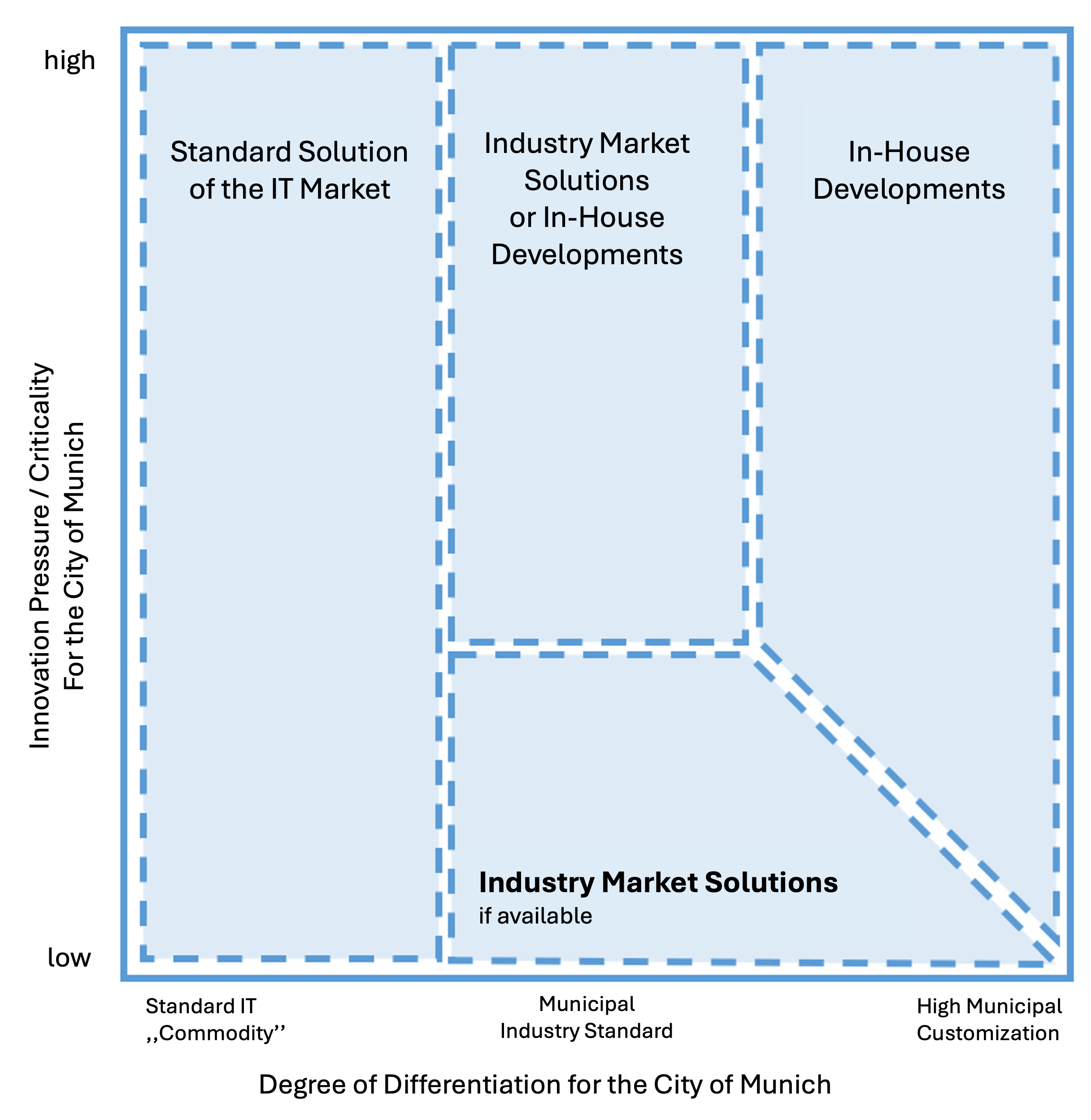Open Source in the Munich City Administration
In Open Source Software, the source code is public and can be viewed, modified and used by third parties. The City of Munich uses open source software for many reasons.
Strategic advantages
- Through open source software, we increase vendor independence. By being able to switch vendors and solutions, we can avoid unilateral dictation of function or price by the vendor.
- The reuse of software is facilitated. Code that is made open source can be easily reused by other agencies or public sector IT providers without contractual agreements or financial arrangements. This can save taxpayer money.
- Cooperations with other government agencies or public sector IT providers are easily possible. This allows LHM to achieve its goals with less budget.
- Publicly accessible code can be easily checked for IT security and security gaps can be closed even without the manufacturer.
- The transparency about the software and its development creates trust in the population towards the administration.
- Committed citizens can participate in projects and thus contribute innovative ideas and reduce the required municipal budget.
- Public Code generates positive public relations and contributes to our recruitment marketing for IT professionals.
Legal and political requirements
In addition to the benefits of open source software for us as an IT service provider, we also comply with legal and political requirements.
The city council elected in March 2020 decided on May 5, 2021:
Die LHM realisiert selbst entwickelte Software unter Berücksichtigung aller relevanten und rechtlichen Faktoren als Open Source Lösungen und beschafft priorisiert Open Source Lösungen, wo immer technisch und finanziell sinnvoll.[1]
The City of Munich will implement software developed in-house as open source solutions, taking into account all relevant and legal factors, and will prioritize the procurement of open source solutions wherever technically and financially feasible.
An important step towards integrating the topic of open source into the orientation of IT was the inclusion of the topic in the strategic orientation of LHM's IT adopted by the City Council on 11.11.2020:
3.6. Die IT der LHM setzt priorisiert Open Source-Lösungen ein, wenn wirtschaftlich und technologisch oder strategisch sinnvoll. Wenn wirtschaftlich und technologisch oder strategisch sinnvoll, setzt die LHM priorisiert Open Source-Lösungen ein, um insbesondere Firmenabhängigkeiten zu vermeiden. Die LHM verfolgt diesen Ansatz sowohl im Anwendungs- als auch im Infrastruktur-Bereich. Die IT der LHM stellt Eigenentwicklungen, die frei von Rechten Dritter sind, als Open Source der Community zur Verfügung.
3.6 LHM IT prioritizes the use of open source solutions when economically and technologically or strategically appropriate. If economically and technologically or strategically sensible, LHM prioritizes the use of open source solutions, in particular to avoid company dependencies. LHM pursues this approach in both the application and infrastructure areas. LHM's IT makes proprietary developments that are free of third-party rights available to the community as open source.
The Bavarian Digital Act - BayDiG Art. 3 Para. 4 Sentence 1
Die Behörden des Freistaates Bayern sollen bei Neuanschaffungen offene Software verwenden und offene Austauschstandards nutzen, soweit dies wirtschaftlich und zweckmäßig ist
The authorities of the Free State of Bavaria shall use open software and open exchange standards for new acquisitions, insofar as this is economical and expedient
... and OZG §4 obliges us to use open software:
(3) Bei der Bereitstellung der IT-Komponenten im Sinne des Absatzes 1 sollen offene Standards und offene Schnittstellen verwendet werden und soll Open-Source-Software vorrangig vor solcher Software eingesetzt werden, deren Quellcode nicht öffentlich zugänglich ist oder deren Lizenz die Verwendung, Weitergabe und Veränderung einschränkt.
(3) When providing the IT components within the meaning of paragraph 1, open standards and open interfaces shall be used and open source software shall be given priority over software whose source code is not publicly accessible or whose license restricts its use, distribution and modification.
Standard
Free software is becoming the standard in modern software development.
Other municipalities, such as the cities of Berlin, Dortmund, Barcelona and many others from the public sector also use and contribute to open source.
But commercial companies are also participating in free software. These are traditionally software companies (e.g. Zalando, Google, Microsoft, Apple) but also companies that do not come from the software industry (e.g. Deutsche Bahn, Mercedes Benz or Siemens).
IT architecture classification
In highly standardized IT areas such as operating systems, network components, databases and end devices, IT architecture relies on the standard solutions of the IT market. This serves to ensure that only those paths are taken which do not prove to be wrong paths or dead ends a few years later. Often, due to the large market, the greatest innovative power is concentrated in the standard solutions, since this is where most resources are invested. Thus, open source solutions are not necessarily used here, but in many areas open source solutions have become established as the standard, and are therefore also used by default at the City of Munich. One example is Linux as the operating system for servers.
Especially in the area of municipal software we are often challenged to develop free software ourselves.

Structuring of the solution space for IT solutions - the approaches differ depending on the classification from the point of view of the state capital Munich
